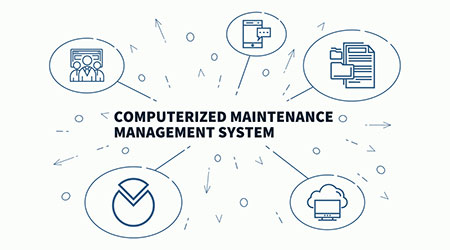Each day, hospitals serve thousands of patients and visitors, control hundreds of different machines and continually support employees – all while remaining open 24 hours a day, seven days a week. Because of this, healthcare facility infrastructures, maintenance machines and computer systems work overtime to accommodate all members within the organization. With multiple maintenance systems working around the clock and oftentimes independently, your facility’s maintenance team encounters more than a few headaches and inefficiencies on a regular basis.
It’s no secret that maintaining a functional, safe healing environment can be a full-time job, after all, the maintenance team needs to be ready at a moment’s notice. To provide extra time for their team members, facilities across the U.S. over the last decade have been implementing a Computerized Maintenance Management System (CMMS) software intended to lower repair costs, ease work order management, boost productivity, meet compliance standards and increase daily efficiency while ensuring the hospital functions at its best.
Evolution of work order management
While hardly an astonishing concept today, maintenance management systems stored digitally on a computer were unheard of only a few decades ago. Prior to the internet boom, maintenance data was generally conducted via pen to paper, causing work orders to easily become lost and forcing a majority of maintenance to be reactive, rather than proactive.
Still today, however, many facilities are managing work orders in less-than-optimal ways. Storing information via countless spreadsheets and uploading hundreds of files may get the job done but sacrifices maintenance technicians’ time in the process. Not to mention that multiple data files across different departments force maintenance teams to view work orders from several lenses, rather than a system-wide whole.
Throw away the pen and ‘X’ out of Microsoft Excel – a CMMS maximizes efficiencies and provides invaluable benefits to turn your organization into a high-functioning healthcare facility. Consider the following three benefits of implementing a CMMS in your organization.
Reduces maintenance costs
In the healthcare field, one organization will have multiple clinical departments and even different locations – but may have only one maintenance team. Developing and maintaining a solid foundation and alignment between departments such as an ER, OR, or lab can prove to be difficult, often leading to inefficiencies or gaps in care. Instead of having one maintenance team handle all departments of a hospital, a CMMS allows for a system-wide overview, providing one big picture of the organization and its current inventory.
A CMMS tells us how much current equipment is present, the criticality of said equipment, and the cost associated with each individual part. Without a CMMS, inventory may not be clearly defined, leading to a multitude of problems down the road. Delays can arise if the necessary parts are unavailable for the task, and the resulting production downtime can lead to higher costs throughout the life of a project. In turn, a CMMS checks for preventative maintenance, reducing overall healthcare costs by utilizing less labor overtime.
Alleviates regulatory overload
Regulatory overload is experienced amongst all healthcare leaders. With more than 629 discrete regulatory requirements across nine regulatory domains, it’s apparent why maintaining compliance throughout a complex healthcare system is difficult. CMMS proves to be a beneficial solution by alleviating regulatory burden due to compliance requirements.
With a CMMS, the maintenance team is notified automatically of continual required testing – without the team having to scramble to make sure everything is up-to-date in the weeks or days leading up to an anticipated Joint Commission (TJC) survey. For example, depending on the type, fire pumps are required to be tested either weekly, monthly or annually. Instead of tracking these tests manually, a computerized system sets up frequent tests, allowing the organization to track current data, see future trends and decipher when the next test will take place. Now, maintenance teams are aware of when testing is required, along with the typical cost associated with said test, so there are no surprises. A CMMS then tracks the system’s full history, forecasts any preventative maintenance and notifies your team when it’s time to test again – letting your team focus on other pertinent tasks.
Creates a culture of accountability
To ensure compliance is routinely met, TJC requires reports to be 100% completed by a certain time. The results and statistics from said report are then shared with not only The Joint Commission committee, but also the healthcare organization as a whole. By managing all the project managers through a CMMS, the facility’s maintenance team has the ability to track their personnel and information daily, allowing them to see common trends throughout the data.
Since all data is stored via the computer, maintenance teams can look at their work orders from a back-log perspective. Program managers are then constantly watching closure rates on the preventative maintenance side. By constantly monitoring PM statistics, managers can see where gaps lie in their personnel, holding them accountable for their actions.
Designed to help healthcare maintenance teams carry out their jobs more efficiently, a CMMS lowers overall costs, maintains continual compliance and creates a culture of accountability amongst the organization. Managing multiple healthcare systems is a full-time job. With a CMMS in tow, your facility’s maintenance team doesn’t have to go it alone.
Larry Lacombe is the Vice President, Program Development, Support and FM Compliance at Medxcel.

 Building Disaster Resilience Through Collaboration
Building Disaster Resilience Through Collaboration Amae Health Expands to New York City
Amae Health Expands to New York City Hospital for Special Surgery Opens Two New Facilities in New Jersey
Hospital for Special Surgery Opens Two New Facilities in New Jersey Should We Be Testing Toilet Water in Patient Restrooms?
Should We Be Testing Toilet Water in Patient Restrooms? Healthcare Union Petitions for Increased Staff Safety at HCA Florida Hospitals
Healthcare Union Petitions for Increased Staff Safety at HCA Florida Hospitals